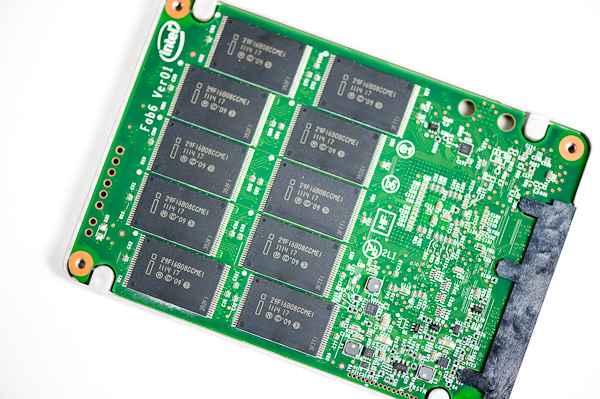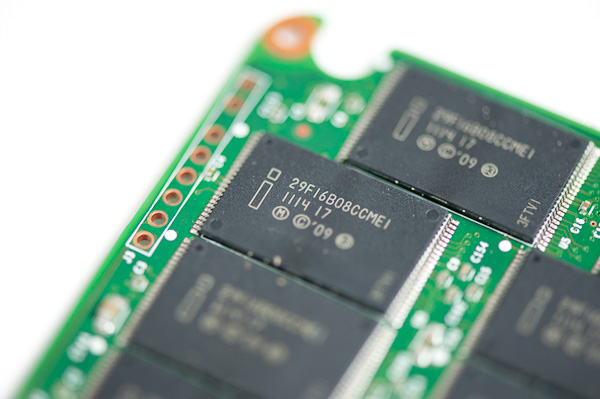The Intel SSD 710 (200GB) Review
by Anand Lal Shimpi on September 30, 2011 8:53 PM EST- Posted in
- Storage
- SSDs
- Intel
- Intel SSD 710
Total Bytes Written & Spare Area

90K p/e cycles seems a bit high and I can't find any Intel documentation that actually quotes that number, it's just what I heard at the 710 briefing in San Francisco. Luckily Intel has another metric it likes to use: total bytes written.
You don't get TBW for client drives, but for enterprise drives Intel will tell you exactly how many tera or petabytes of random 4KB or 8KB data you can write to the drive. These values are "up to" of course as actual lifespan will depend on the specific workloads.
| Intel SSD Endurance Comparison | |||||||
| X25-E 32GB | X25-E 64GB | 710 100GB | 710 200GB | 710 300GB | |||
| 4KB Random Writes | 1.0 PB | 2.0 PB | 500 TB | 1.0 PB | 1.1 PB | ||
| w/ +20% Spare Area | - | - | 900 TB | 1.5 PB | 1.5 PB | ||
Doing the math these values work out to be about 5K writes per cell (~5243), however that's assuming no write amplification. Performing a 100% random write across all LBAs for a full petabyte of data is going to generate some serious write amplification. The controller in the 710 tends to see write amplification of around 12x for 4KB random writes, which would put the rated cycle count at just under 63,000.
There's just one problem. The 200GB 710 I'm basing these calculations on doesn't actually have 200GB of NAND on-board, it has 320GB.
Opening up the 710 that Intel sent me I found a total of 20 NAND packages on-board. This isn't surprising as Intel's controllers have always supported 10 parallel NAND channels, in this case the 710 uses two packages per channel and interleaves requests to them. Each NAND package however has 128Gbit (16GBytes) of NAND inside in the form of 2 x 8GB 25nm MLC-HET die. Multiply all of that out and you get 320GB of NAND inside this 200GB drive.
Of course 200GB is defined as 200,000,000,000,000 bits, so actual binary storage capacity is 186.3GiB. This is absolutely insane: over 41% of the NAND on the 710's PCB is set aside as spare area. We have never reviewed an SSD with anywhere near this much spare area before.
If we run the p/e count with 320GB as the actual amount of NAND available, it works out to be just under 40K p/e cycles per cell. The significant spare area on the 710 increases the drive's projected lifespan by 55%! Intel even recommends setting aside another 20% of the drive if you need a longer lifespan. An extra 20% spare area will give you another 50% increase in total bytes written. Tinkering with spare area just helps reduce write amplification, it doesn't magically make the NAND cells last longer.
If we believe Intel's specifications, MLC-HET actually sounds pretty decent. You get endurance in the realm of the X25-E but at significantly lower cost and with more reasonable capacity options.
Thankfully we don't need to just take Intel's word, we can measure ourselves. For the past couple of years Intel has included a couple of counters in the SMART data of its SSDs. SMART attribute E2h gives you an accurate count of how much wear your current workload is putting on the drive's NAND. To measure all you need to do is reset the workload timer (E4h) and run your workload on the drive for at least 60 minutes. Afterwards, take the raw value in E2h, divide by 1024 and you get the percentage of wear your workload put on the drive's NAND. I used smartmontools to reset E4h before running a 60 minute loop of our SQL benchmarks on the drive, simulating about a day of our stats DB workload.
Once the workloads finished looping I measured 0.0145% wear on the drive for a day of our stats DB workload. That works out to be 5.3% of wear per year or around 18.9 years before the NAND is done for. I'd be able to find more storage in my pocket before the 710 died due to NAND wear running our stats DB.
For comparison I ran the same test on an Intel SSD 320 and ended up with a much shorter 4.6 year lifespan. Our stats DB does much more than just these two tasks however - chances are we'd see failure much sooner than 4.6 years on the 320. An even heavier workload would quickly favor the 710's MLC-HET NAND.
But what about performance? SLC write speeds are much higher than MLC, but Intel's MLC performance has come a long way since the old X25-E. Let's get to the benchmarks.
The Test
We're still building up our Enterprise Bench data so forgive the lack of comparison data here. We included a number of consumer drives simply as a reference point.
| CPU |
Intel Core i7 2600K running at 3.4GHz (Turbo & EIST Disabled) |
| Motherboard: |
Intel H67 Motherboard |
| Chipset: |
Intel H67 |
| Chipset Drivers: |
Intel 9.1.1.1015 + Intel RST 10.2 |
| Memory: | Qimonda DDR3-1333 4 x 1GB (7-7-7-20) |
| Video Card: | eVGA GeForce GTX 285 |
| Video Drivers: | NVIDIA ForceWare 190.38 64-bit |
| Desktop Resolution: | 1920 x 1200 |
| OS: | Windows 7 x64 |













68 Comments
View All Comments
Stas - Sunday, October 2, 2011 - link
Makes you wonder: how did Anandtech survive in the olden days?Anand Lal Shimpi - Friday, September 30, 2011 - link
I didn't preview Bulldozer because it would've been a disservice to the community. The performance levels of chips we had access to prior to going under NDA with AMD just wasn't representative of anything.Don't worry, you'll get to hear about Bulldozer soon enough :) AMD said shipping in Q4...
Take care,
Anand
Voidman - Friday, September 30, 2011 - link
I actually would have agreed with this comment a lot more a year ago, or even 6 months ago. I am starting to see a few actual PC builder related reviews in recent months, and am happy about it. (Of course consumer SSD's are of interest to home builders, but that was about the only thing here that was). I was pleasntly surprised to see several reviews on cases/enclosures, something I have not seen here for a long time. And a PSU and monitor review here and there also. All of this came too late for my last build, but it is nice to see anyway.It does seem that there was a decision a couple of years ago to concentrate on smart phones and tablets and home theater gear, with SSD and enterprise IT articles filling in the gaps. I hope the recent trend of more PC builder related articles and reviews continues.
kevith - Saturday, October 1, 2011 - link
Apples products are interesting because they show the way. Tablets, phones and OS, they have the best. (And most expensive and hyped and with a congregation that's gross). But when Apple launches a product, EVERYONE else will try to copy it within months, whether you like it or not. Thats why its interesting reading.Enterprise hardware is interesting to read about because it shows what a new piece of hardware are ACTUALLY capable of. In this case it shows, that if you want a real reliable SSD, the "nickels and dimes", that a consumer-SSD costs is simply not enough.
THizzle7XU - Saturday, October 1, 2011 - link
"Apples products are interesting because they show the way."I actually feel like the media at this point puts Apple in a position to create a self fulfilling prophecy in this regard. The iPad is the greatest example of this. Before the iPad came out there were rumors for years, pretty much since the iPhone debut, that Apple was working on a tablet and how it would be the greatest thing ever. I feel like after the rumors went on for a while, Apple was like, "Ya, this thing sounds cool! Maybe we should build a tablet!". And then all the other manufactures sat on their hands while the obvious was happening waiting for Apple to release the design template when the blueprint was crystal clear for tablets (i.e. just their phone OS on a bigger screen with slight modifications to the apps to take advantage of the screen res).
It's like Apple pays its competitors not to compete with its ideas until they have released their product. And they everyone else becomes a copy cat of ideas that were so painfully obvious in the first place because they inexplicably waited until Apple released their version.
Stas - Sunday, October 2, 2011 - link
How dare you?! Steve Jobs created the universe. zOMG I'm getting wet dreaming about iPhone 5 !!!11!11!111inplainview - Sunday, October 2, 2011 - link
I must suck being you....Hulk - Friday, September 30, 2011 - link
I've been here from day one and Anand keeps getting better. In my opinion he has always been the best tech writer on the internet and now I see his thoughts are as clear an organized when doing a video review. Bravo!Kudos to all of the guys on the Anandtech site. The flavor of all of the reviews flows down to everyone here. Anand is still the best but luckily he is rubbing off on all his guys.
wxrkny - Friday, September 30, 2011 - link
"Anand is still the best but luckily he is rubbing off on all his guys."I hope not, that's gross
sorry I had to
TommyAU - Friday, September 30, 2011 - link
Haha